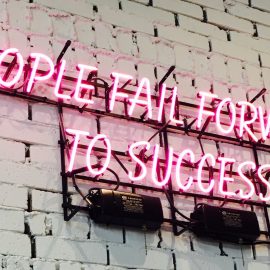

This article gives you a glimpse of what you can learn with Shortform. Shortform has the world’s best guides to 1000+ nonfiction books, plus other resources to help you accelerate your learning.
Want to learn faster and get smarter? Sign up for a free trial here .
Do you have a hard time accepting change and moving forward to the next chapter in your life? How does refusing to embrace change prevent you from living to the fullest?
In all aspects of life, there is only one thing that is certain, and that is change. Therefore, resisting change is resisting life itself. If you want to live a rich and fulfilling life, you need to work on accepting change—good and bad, big and small, expected or unexpected.
Here’s a guide on how to accept change and move forward without regrets and resistance.
What Not to Do When Handling Change
When change happens, many people struggle to accept it, hoping that things will return to the way they were. But if your world really has changed, the longer you entertain that false hope, the more difficult it will be for you to move forward again.
Therefore, accepting change starts with letting go of the false hope that things will go back to the way they were. Don’t try to bring back the past by working harder in the hope you can stem the tide of change—that approach is futile. What used to work may no longer work in the new situation. Practically, this might mean:
- If you’re about to be laid off for larger economic reasons, trying harder to do your job might not rescue your job. And finding the same job elsewhere might be worse than learning new skills to transition to a new job.
- Approaching a broken relationship the same way you always have won’t rescue it.
Finally, don’t dwell on the unfairness of it all. When change impacts you, it’s easy to get hung up on the “unfairness” of having your life disrupted. But if you get stuck on that thought, you’ll end up hurting yourself. Fair or unfair, the change has happened. Now you have to deal with it.
How to Accept and Handle Change Successfully
Change is a natural and inevitable part of life, and resisting inevitability is futile and frustrating. Although you might feel satisfied for a brief period, staying static in the face of change could eventually lead to extinction.
As mentioned earlier, the first step to accepting change is to kill the false hope that things will revert to the way they were. Accept the new state of affairs and move forward quickly. The longer you wait, the more resistance you build to moving, and the harder it’ll be to adapt later. Many people who finally muster the courage to leave a job or relationship that’s not working for them, often wonder in retrospect why they hadn’t made the change sooner.
As the change unfolds, commit to maintaining a positive outlook and keeping an open mind to new things: There are always experiences and opportunities available beyond those you are currently familiar with. New experiences, discoveries, and achievements are stimulating and rewarding, and you might like them even more than what you used to have.
Finally, always be on the lookout for signs of change in your environment, whether it’s layoffs at your workplace, new aches and pains, or strains in your home life. Consider how potential changes could affect you and develop a plan to handle them—for instance, by learning new skills.
TITLE: Who Moved My Cheese?
AUTHOR: Spencer Johnson
TIME: 21
READS: 27.6
IMG_URL: https://www.shortform.com/blog/wp-content/uploads/2020/01/movedcheese_cover.jpg
BOOK_SUMMARYURL: https://www.shortform.com/summary/who-moved-my-cheese-summary-spencer-johnson
Surrendering to Illness and Suffering
Dealing with money problems or a job you don’t like is one thing. But how can you work on accepting changes that are painful, unsettling, or even tragic—like illness or death of a loved one?
In his book The Power of Now, spiritual teacher Eckhart Tolle says that you have two chances at surrendering to such changes:
- You can surrender to the circumstances of the Now, because you can’t change what already is.
- If you can’t surrender to the external, surrender to the internal. Surrender to the pain, grief, sadness, fear, or loneliness you are feeling. Allow yourself to feel this way without judging, analyzing, or pitying yourself.
Once you recognize and accept these negative emotions, you are less likely to blindly act on them. However, at some point, you will need to stop creating this negativity. Otherwise, your acceptance just becomes indulgence that allows you to carry on in this mental pattern. Don’t use temporary escapes—such as work, drugs, sex, alcohol, food, shopping, or any other short-term pleasure—to avoid the pain. If you do, the pain will be waiting for you, possibly more intensely, when that pleasure fades.
Finally, there is a silver lining to even the most unwanted and painful changes. You can use pain, illness, and suffering to push you deep into presence and enlightenment. Through extreme circumstances and pain, you may find yourself in a position where you have nowhere else to turn but inward to finally find peace and enlightenment.
TITLE: The Power of Now
AUTHOR: Eckhart Tolle
TIME: 28
READS: 30.1
IMG_URL: https://www.shortform.com/blog/wp-content/uploads/2019/08/powerofnow_cover.jpg
BOOK_SUMMARYURL: the-power-of-now-summary-eckhart-tolle
AMZN_ID: B002361MLA
How to Successfully Enact Change
So far, we’ve discussed accepting change that’s unexpected, destabilizing, and undesirable. But what if you do desire change, but find it difficult to make it a reality? Anyone who’s ever tried to quit smoking or go on a diet knows how hard it is to make changes. Polls on the success of people attempting to make personal changes show failure rates from 50% to as much as 96%.
According to Chip and Dan Heath, the authors of Switch: How to Change Things When Change Is Hard, making successful changes depends on three essential elements: 1) your rational side, 2) your emotional side, and 3) the environment you shape.
Element #1: Rational You
Your rational side is the part of you that sets goals, plans for the future, and carefully analyzes problems before taking action. In short, this is the “you” that you want to be.
However, there’s a major hidden flaw of your rational side that actually holds you back from making changes. Your rational side tends to overthink problems, overanalyze possible solutions, and get stuck in details, information, and options. Though your rational side wants to make a change, it paralyzes itself and holds you back from taking action.
For example, making plans to exercise more is fairly straightforward. However, your rational side will go into overdrive—analyzing the types of exercise you like and dislike, trying to find the best workout routine for your body type and goals, researching gym memberships, checking where exercise will fit into your busy schedule, and so on. Instead of exercising more, you get stuck thinking about exercising more.
Element #2: Emotional You
Your emotional side is the part of you that acts instinctively and is easily driven by the possibility of instant gratification. When changes fail, it’s usually your emotional side’s fault—change hinges on the ability to delay gratification and make short-term sacrifices in exchange for a long-term payoff.
However, there’s a major hidden advantage of your emotional side that can drive successful change. Your emotional side is much stronger than your rational side—if you can harness the energy of your emotions and point it in the right direction, it will do most of the legwork in getting you to your goal.
For example, if your goal is to get more exercise, you might get yourself excited and emotionally invested in exercise by focusing on how you’ll feel when you finally complete your first marathon. It becomes easier to put on your running shoes once you elevate exercise from an obligation to an exciting process with an emotionally charged goal.
| Rational You and Emotional You Must Sync Up When change fails, it’s often due to a conflict for control between your rational side and your emotional side. Jonathan Haidt explains this conflict in The Happiness Hypothesis, where he compares the struggle between your rational side and emotional side to a rider atop an elephant, urging it forward. The elephant is far stronger than the rider—if they have different ideas about where to go, the rider will lose every time. This is why, even though you rationally understand the importance of sticking to your diet, you give up and indulge as soon as you see something you’re craving. The elephant overpowers the rider and drives you straight into a cheesecake. |
Element #3: The Path Forward
The “path forward” is the environment you create around a change—a successful path is shaped to keep both the rational rider and the emotional elephant moving forward together.
A clear, successful path has two important elements:
- There aren’t any instant-gratification distractions lying in sight, off to the side. These temptations will cause your emotional side to overpower your rational side, veering off the path and getting lost.
- The road is straight and clear of roadblocks. These will cause your rational ride to stop and overthink which direction to move in or how to solve the roadblock. The pair will never make it to their destination.
Interestingly, the path can either work independently of your rational and emotional elements, or it can work in tandem with them.
- The path can be an independent “quick track” to change. However, this only works if it’s absolutely foolproof—that is, the path is completely straight and clear with no distractions. This can be very difficult to achieve, meaning distractions are likely to happen. And, because you bypassed getting a handle on your rational and emotional selves, these small distractions irreversibly derail your progress toward change.
- The path works better as an aid to your in-sync rational and emotional sides. On this path, there may be distractions or unexpected twists—but since your rational and emotional selves are a balanced team, you can shake off the road bump and continue moving forward.
TITLE: Switch
AUTHOR: Chip and Dan Heath
TIME: 34
READS: 97.6
IMG_URL: https://www.shortform.com/blog/wp-content/uploads/2020/11/switch-cover.png
BOOK_SUMMARYURL: switch-summary-chip-and-dan-heath
AMZN_ID: XYZ
Final Words
We all experience change in our lives. It can be distressing or rewarding, depending on whether you choose to accept it and adapt or resist it and complain about it.
If you enjoyed our article about accepting change, check out the following suggestions for further reading:
In Loving What Is, best-selling author and spiritual teacher Byron Katie argues that you don’t have to resign yourself to living in a constant state of misery. She explains that life experiences don’t cause emotional pain, only resistant thoughts that judge experiences as somehow wrong or unwanted. Therefore, releasing resistant thoughts allows you to accept and feel at peace with life, no matter what happens.
In this book, Tara Brach, a practicing psychologist and devout Buddhist, discusses how we can use the meditative practice of Radical Acceptance to live our lives more fully by always bringing our full attention to the present moment and accepting it for what it is. You’ll learn how we get trapped in the stories we tell ourselves, and how Radical Acceptance can bring us out of the trance.

Want to fast-track your learning? With Shortform, you’ll gain insights you won't find anywhere else .
Here's what you’ll get when you sign up for Shortform :
- Complicated ideas explained in simple and concise ways
- Smart analysis that connects what you’re reading to other key concepts
- Writing with zero fluff because we know how important your time is






